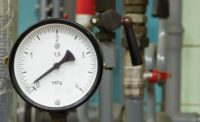When designing or replacing a low pressure steam boiler, throw out everything you know about hydronic boilers. A steam system is closer in operation to an air conditioning unit than it is to a hydronic boiler. If you design a steam system using hydronic design methods, it will not operate properly. A hydronic system uses sensible heat while a steam system uses both sensible and latent heat. Sensible heat can be measured with a thermometer while latent heat causes a change of state and cannot be measured accurately with a thermometer. The water inside the boiler will change state from a liquid to a vapor and then back to a liquid during the heating process. Steam systems are more holistic than hydronic ones because a problem in one area could affect the entire system. The following are some of the steps I take when designing a replacement steam system.
Always assume. I know we have been told to never assume in life, but in this case, you should always assume there is a problem with an existing steam heating system and you will inherit the problem when the new boiler is installed. I like to ask the customer, “Which areas are the hardest to heat?” This simple question may help uncover any system issues now rather than after the new boiler is installed.
Walk through the building. I urge you to walk through the building and look for sags in the piping or missing insulation. A customer had a classroom with no heat, and by the time I got there, they were on their third replacement trap and still having issues. We found the cause of the problem was a sag in the return pipe three stories below. The pipe hanger came apart, causing the pipe to sag and creating a water seal that stopped the air from being vented from the piping. Industry expert Dan Holohan suggests the problem and the solution are rarely in the same room on steam systems.
Can air escape? I used to have a car I loved, but it had a huge drawback. Every time I would pump gasoline into the tank, the pump would always shut off. It did not matter how slow or fast I pumped or how far in the gas tank opening the nozzle went, and it was frustrating. The problem was that the air inside the gas tank could not escape the tank opening when the gas nozzle was pumping. If air was in the tank, the gasoline would not flow. It is like a steam system. When the boiler is off, the piping is filled with air. Once the boiler starts generating steam, the steam will push the air through the piping and vent it through the condensate piping and out the boiler feed unit vent. Sags in the piping create a water seal that can stop the air from venting and the steam from flowing. Ask yourself this simple question, “If I were air, how would I escape?”
Steam Pressure. During the walkthrough, I like to note the boiler pressure setting. Since December 1899, low pressure steam systems for comfort heating applications have been designed to heat the building using 2 Psig steam pressure. If the boiler is operating at pressures above 2 Psig, there could be a system problem warranting investigation. The Empire State Building in New York City, at 1,250 ft and 102 stories high, heats the building with 2 lbs of steam pressure. If a building that size can heat the building on 2 Psig pressure, I would wager you could do the same.
Why 2 Psig? Let us assume we have a boiler operating at 7 Psig, which means the steam temperature will be 232.4˚F. Steam traps will open and discharge condensate when the temperature drops 10-20˚F, making the temperature of the condensate between 212˚ and 222˚F. Since it is above the boiling temperature of water, the condensate will flash to steam, rendering the traps inoperable because you now have steam on both sides of the trap. A steam trap requires a pressure differential to operate. It is not the end of the system problems.
The flash steam enters the condensate receiving tank and raises the temperature of the water. Most condensate pumps are designed to handle temperatures no higher than 200˚F. The elevated condensate temperature could destroy the boiler feed pump. In addition, the condensate could flash to steam inside the boiler feed pump. The water pump cannot pump steam so the boiler will not get the required water to operate and will shut off. Also, the flash steam will escape the system via the vent, and the system will introduce fresh untreated water increasing scale and water treatment costs. These issues almost disappear when operating the system at 2 Psig.
Sizing the replacement boiler. Sizing a replacement steam boiler differs from a hydronic one because the boiler sizing is based on the connected load and not the building heat loss. The connected load includes all heat emitters such as radiators, coils, and baseboard radiation. After you calculate the connected load, you have to add 30-40% more to cover the heat required to warm the pipes from a cold start. There may be miles of pipe in a building.
How many boilers? Once you have calculated the heating load for the building, you have to decide how many boilers you will use. While one boiler is less expensive, I would be hesitant to do that because if something breaks down, the customer will be without heat and calling you. I would consider two the minimum and prefer using four. Four boilers will give greater backup capacity, better seasonal efficiency, and higher turndown ratio.
Dry steam. The system is designed to work best with dry steam. Wet steam means some of the water from the boiler will be carried along with steam. This will lower the steam temperature, reducing system efficiency. In addition, it will increase maintenance costs. Wet steam could overload the steam traps and cause them to stall, which stops the heating process.
Piping the boilers. The near boiler piping is the piping directly attached to the boiler and used to dry the steam going to the system. The boiler manufacturer’s instructions should be consulted for proper design. A client had a cast iron sectional steam boiler with a massive steam leak. The installer did not include a swing joint and the expansion of piping pulled the sections apart causing the leak. A major re-piping was required to repair the problem. The swing joint is used to absorb the expansion and contraction of the piping.
The main steam supply pipe to the system will contain condensate as well as steam. The piping should be pitched .25 in to .50 in per 10 ft away from the boiler to allow the condensate to flow to the end of the pipe.
Two feet to drier steam. Many boiler manufacturers recommend a vertical steam riser of 2 ft or more coming from the boiler to dry the steam. Be sure the boiler room has the space above the boiler for the vertical riser.
Velocity. I did a study of 50 of the most popular steam boilers used today and found the average steam velocity of the near boiler piping was 45.77 ft per second. I like to design my systems using 40 ft per second.
Connecting boiler to building piping. When connecting a new steam boiler to the existing piping, the steam piping should connect to the top of the horizontal steam header. This is called a drop header and is used to assure dry steam to the building. If the steam piping is connected to the bottom of the header, the condensate in the piping will drop back into the boiler and could cause flooding or banging. If you cannot pipe the steam into the top of the steam piping, the riser should be trapped so the condensate does not drip back to the boiler. All steam takeoffs to the system should come from the top of the header.
Collecting the condensate. When the steam leaves the boiler, it zooms around the pipes with speeds up to 60 miles per hour looking for someplace cold to surrender its latent heat and revert back to a liquid. Once it converts back to condensate, it travels along the condensate piping back to the condensate return tank, where it will be pumped to the boiler when the boiler water level drops.
Condensate return system. When the condensate returns from the system, it is gathered in a condensate return system. There are two different types of condensate return systems, condensate tank or boiler feed.
A condensate tank is a smaller tank, typically 12-20 gal in capacity. The tank has an internal float to energize the pump when the water level rises in the tank. These tanks are used as a transfer tank to gather the condensate in the far ends of the building and send it to the boiler feed tank. These should not be used to feed water directly to the boiler. Instead, a boiler feed unit is used for feeding water to the boiler.
A boiler feed unit is a much larger tank, usually about 1-3 gal of storage per boiler horsepower. The actual size is dependent on jobsite conditions. The boiler feed pump is controlled by a level control mounted on the boiler. The cool makeup water for the heating system is introduced into the boiler feed tank where it is pre-heated and chemically treated before being injected into the boiler. The boiler feed unit is usually where the water treatment chemicals are injected into the system. Check with the boiler feed manufacturer to see if the chemicals can be introduced here as some will void the warranty if the chemicals are introduced into the tank. When sizing the tank, you are better off with a slightly oversized tank than an undersized one. An undersized tank will overflow and lose the chemically treated water.
Multiple boiler staging. When using modular steam boilers, you cannot control them like you would a hydronic system. I prefer starting all the boilers at the same time and once steam pressure is established, you could start dropping the boilers off or back. Think of it like an airplane taking off. The pilot gives full thrust to the engines to get off the runway. Once the plane hits cruising altitude, the pilot pulls back the throttle and allows the plane to coast.
Control or zone valves. When used on steam systems, they could allow a vacuum to form in the system. A vacuum will create all sorts of strange behavior in the system, including pulling the water from the boiler or even the boiler feed tank. A vacuum breaker should be used when control valves are installed.
Pipe insulation. An uninsulated steam pipe will allow the steam to condense prematurely. This cools the steam, reducing the efficiency and increasing the maintenance of the system. Missing pipe insulation could also cause the steam traps to overload and cause the system to stall, stopping the heat.
In addition, uninsulated pipes will lose about 80 times more heat than an insulated pipe, making the boiler room very warm. The International Mechanical Code requires pipe insulation on all projects. Consider insulating the condensate piping as this will reduce the damage from carbonic acid on the inside of the return pipes.
Double trapping. When you see a trap on the condensate pipe at the entrance of the condensate or boiler feed tank, be warned. You will be inheriting a problem job! The problems most likely started when one or two traps in the building started to leak steam. The boiler feed vent would start spewing steam into the boiler room. Someone then decided to install a “master” trap at the inlet to the condensate or boiler feed tank instead of repairing the traps. This is wrong and will adversely affect the operation of the system as the system cannot vent air. The customer may have to rebuild or replace the system traps.
Steam trap life. According to SchoolFacilities.com, the average life of a thermostatic steam trap element is about three years and about six years for a float mechanism in a steam trap. When replacing a steam boiler, I like to replace or rebuild the steam traps in the building. We did this for a large apartment building in my area, and the owner told us their fuel costs dropped dramatically.
Blowdown tank or cooler. A steam boiler will require regular blow downs to remove undesirable items in the boiler such as solids or oils and to test the low water cutoffs. According to the National Board, solids concentrated in boiler water tend to promote foaming and scaling with a resultant loss of heat transfer which may result in overheating of the boiler tubes. The International Plumbing Code 701.7 states the boiler blow off temperature entering the building drain must be below 140˚F. If you allow the hot condensate to enter the drain piping, it could destroy the drain piping. For this reason, a blow down tank or cooler is installed. A blowdown tank is an ASME code tank sized large enough to hold the blowdown of a boiler until it is cooled (usually enough for three blowdowns). When the tank is full, the new hot blowdown displaces the older, cooled blowdown. A blowdown cooler (or separator) is smaller than a blowdown tank and mixes city water into the boiler blow down water to reduce the temperature to 140˚F or lower. The sizing of the blowdown tank should be according to the boiler manufacturer.
Water softener. A softener is a good idea for a steam system as it will reduce the scale inside the boiler and lower the chemical treatment requirements for the system.
High level spill. When more than one steam boiler is used in a physical plant, the idle boiler will usually flood. If this happens, the boiler may not fire. If there is more than one boiler, ASME recommends installing a high-level spill trap at an elevation about 1-2 in above the normal water line. If the water level raises to that point, the steam trap opens and the water is sent back to the condensate tank, eliminating the chance of boiler flooding.
Cleaning the new boiler. Every newly installed steam boiler should be cleaned prior to being put in service. The installation process causes many undesirable things to find their way inside the boiler, including dirt and oils. The oils are usually from the pipe threading process. These contaminants can cause all sorts of problems including surging and foaming inside the boiler. In severe instances, this could cause the boiler water level to bounce and shut the boiler off on low water. Verify with the manufacturer about how to clean their boiler.
Good luck on your next steam boiler installation. ES








